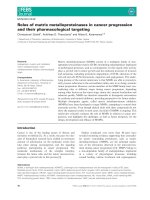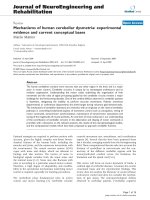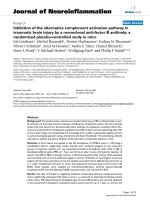Báo cáo hóa học: " Morphologies of Sol–Gel Derived Thin Films of ZnO Using Different Precursor Materials and their Nanostructures Harish Bahadur Æ A. K. Srivastava Æ R. K. Sharma Æ Sudhir Chandra" pdf
Bạn đang xem bản rút gọn của tài liệu. Xem và tải ngay bản đầy đủ của tài liệu tại đây (375.21 KB, 7 trang )
NANO REVIEW
Morphologies of Sol–Gel Derived Thin Films of ZnO Using
Different Precursor Materials and their Nanostructures
Harish Bahadur Æ A. K. Srivastava Æ
R. K. Sharma Æ Sudhir Chandra
Received: 14 June 2007 / Accepted: 14 August 2007 / Published online: 9 September 2007
Ó to the authors 2007
Abstract We have shown that the morphological features
of the sol–gel derived thin films of ZnO depend strongly on
the choice of the precursor materials. In particular, we have
used zinc nitrate and zinc acetate as the precursor materi-
als. While the films using zinc acetate showed a smoother
topography, those prepared by using zinc nitrate exhibited
dendritic character. Both types of films were found to be
crystalline in nature. The crystallite dimensions were
confined to the nanoscale. The crystallite size of the
nanograins in the zinc nitrate derived films has been found
to be smaller than the films grown by using zinc acetate as
the precursor material. Selected area electron diffraction
patterns in the case of both the precursor material has
shown the presence of different rings corresponding to
different planes of hexagonal ZnO crystal structure. The
results have been discussed in terms of the fundamental
considerations and basic chemistry governing the growth
kinetics of these sol–gel derived ZnO films with both the
precursor materials.
Keywords ZnO thin films Á Morphologies Á Sol–Gel Á
XRD Á SEM Á TEM
Introduction
ZnO is one of the most important nanomaterials for inte-
gration in microsystems and biotechnology. It is a
semiconductor with a wide band gap of 3.37 eV and large
exciton binding energy of 60 meV. This makes it useful in a
number of photonic applications. Due to its non-centro-
symmetric characteristics, it is piezoelectric and is used in
electromechanical coupled sensors and transducers. Thin
films of zinc oxide have a large number of technological
applications including a variety of sensors. The preparation
of ZnO thin films has been the subject of continuous research
for a long time because the properties of ZnO films depend
upon the method of preparation. Currently, there is a great
interest in the methods of creating nanostructures on surfaces
by various self-organizing techniques. These nanostructures
form the basis of nanotechnology applications in sensors and
molecular electronics for next generation high performance
nano-devices. ZnO exist in a variety of nanostructures [1]
and is expected to be the next most important nanomaterial
after the carbon nanotubes.
In the present communication, we shall show that the
morphological features of the sol–gel derived thin films of
ZnO depend strongly on the choice of the precursor
materials. Sol–gel technique of film preparation is a low-
cost process and is attractive as the film properties can be
tailored conveniently for a given application. The process
thus becomes a preferred option over the expensive tech-
niques such as MBE, MOCVD etc to synthesize materials
for exploratory studies. A large number of candidate
materials, which require screening for their compositions
and properties prior to their applications in devices, can be
produced at low cost using the sol–gel process. In general,
zinc acetate is the precursor material for preparation of
ZnO films using sol–gel process or spray pyrolysis
H. Bahadur (&) Á A. K. Srivastava Á R. K. Sharma
National Physical Laboratory, K.S. Krishnan Road, New Delhi
110012, India
e-mail:
S. Chandra
Center for Applied Research in Electronics, Indian Institute of
Technology, Hauz Khas, New Delhi 110016, India
123
Nanoscale Res Lett (2007) 2:469–475
DOI 10.1007/s11671-007-9089-x
techniques [2–5]. However, zinc nitrate has also been used
for preparation of nanosized zinc oxide powder. For
example, Liu et al. [6] have described the formation of
ordered porous ZnO film using zinc nitrate by electro-
deposition method using polystyrine array templates.
Studenikin et al. [7] describe the formation of undoped
ZnO film by spray pyrolysis of zinc nitrate solution at high
temperature. Zinc nitrate is also used for the synthesis of
ZnO nanoparticles [8]. Micropatterns of ZnO have been
synthesized [9] on photocatalytically activated regions of
TiO
2
in an aqueous solution of zinc nitrate and dimethyl-
amine-borane by an electroless deposition process. The as-
deposited ZnO micropatterns showed a polycrystalline
wurtzite structure. There are several reports [6–8] in which
ZnO has been grown using zinc nitrate as the starting
material. However, most of the papers reported involve
either spray pyrolysis using a solution of zinc nitrate or
electrodeposition process.
Our earlier work [10–15] has shown that the films grown
by zinc acetate and zinc nitrate as precursor materials show
different morphological features. Films grown by zinc
nitrate show a rapid and random crystallization than the
films grown by zinc acetate. A smoother topography is
obtained for the films grown by using zinc acetate than for
the films grown by zinc nitrate. Scanning tunneling
microscopy showed that the films grown by zinc acetate as
precursor were uniform. Nano-structured ZnO grains of
size ranging from 20 to 60 nm were obtained on the film
grown by sol–gel spin process using zinc nitrate as pre-
cursor material on a quartz substrate. Individual grains
showed a sharp contrast with different facets and bound-
aries. In this paper, we shall present our results and extend
a discussion in terms of basic chemical reactions giving our
reasoning to the observed morphologies. We shall describe
and discuss the results separately for the two types of
precursor materials used. For a ready reference and
coherent discussion, some of the micrographs will be
reproduced from the previous papers [10–15 ].
Experimental
The films were grown by sol–gel technique on silicon and
fused quartz substrates. The reason for choosing two types
of substrates, silicon and quartz, was to check the depen-
dency of morphological features whether they are
characteristics of sol or substrates. The sols were prepared
by using two different routes and precursor materials viz.
zinc nitrate and zinc acetate. Accordingly, the solvent
chosen were also different. The reason for using two dif-
ferent solvents was due to the fact that the solubility of two
precursor materials zinc nitrate and zinc acetate is different
in their solvents. While zinc nitrate was dissolved in
ethylene glycol monomethyl ether, zinc acetate was dis-
solved in isopropyl alcohol. Both the sols were made to
have sufficient amount of the precursor material dissolved
under the limit of equilibrium reaction. It may be men-
tioned here that all chemicals used were procured from
E.Merck (Germany) and were of AR grade.
The growth procedure consisted of first making the
surface of the silicon substrate hydrophilic by boiling the Si
wafer in 70% HNO
3
followed by rinsing in de-ionized
water and subsequent drying. This process oxidizes the Si
surface to SiOH and improves its adhesion. The sol was
prepared by two different routes. The first route involved
dissolving 10 g of zinc nitrate [Zn(NO
3
)
2
Á 6H
2
O] in
100 mL of ethylene glycol monomethyl ether [CH
3
O–
CH
2
–CH
2
OH] to form the zinc solution. The other route of
sol preparation was to prepare 10% solution of zinc acetate
[Zn(CH
3
COO)
2
Á 2H
2
O] by dissolving 10 g of zinc acetate
in 100 mL of boiling isopropyl alcohol at 84 °C. This was
followed by clarifying the turbid solution by adding a few
drops of diethanolamine. For the film preparation, a Si
wafer was mounted on a spinner and the sol was placed on
top of it and the wafer was allowed to spin at the rate of
3000 rpm. This step was followed by drying the coated
wafer at 100 °C and subsequent baking at 450 °C for one
hour. Films were prepared using both the routes one by
one. Multiple coatings were done to obtain the workable
thickness of the film using both the routes of sol prepara-
tion. The ellipsometric data show that for ten coatings, the
film thickness was only of the order of 2000–2500 A
˚
.
Bright field high magnification micrographs were recorded
by using a transmission electron microscope (TEM model
JEOL JEM 200Cx) operated at 200 kV to investigate the
different morphologies observed under SEM.
Results and Discussion
It may be mentioned here that visually the films appeared
continuous and uniform and blue in color.
1
However, when
examined under scanning electron microscope, in general,
1
The blue color corresponds to the difference in the refractive index
between the material (ZnO on Si substrate) and the air. For a high-
index material such as Si, the surface reflection is about 35% of the
incident light in an air environment. For the minimum reflection, the
index of coating must satisfy the condition
n
c
¼ðn
1
n
2
Þ
1=2
ð1Þ
where n
c
,n
1
,n
2
are the refractive indices of coating, medium and
substrate, respectively. The thickness of the coated film is then
determined by the equation
t
c
¼ k
0
=4n
c
ð2Þ
where k
0
is the wavelength where zero reflectivity is desired.
470 Nanoscale Res Lett (2007) 2:469–475
123
the films grown by using two different precursor material
showed different kinds of morphologies. Having observed
the difference in the morphologies, we have investigated
the nature of products formed when zinc nitrate and zinc
acetate were subjected to different conditions of hydrolysis.
In the case of zinc nitrate, it was observed that pure zinc
nitrate is recovered unchanged even after boiling for two
hours whereas zinc acetate always give basic zinc acetate
or zinc hydroxide depending upon the time of boiling.
These results were confirmed by infrared absorption mea-
surements and will be described elsewhere.
Zinc Nitrate as the Precursor Material
The SEM examination of the films revealed that the films
grown by using zinc nitrate exhibited dendritic character
with agglomeration of dendrities. As an example, the set of
micrographs in Fig. 1 depict the general character of
morphological features as revealed by SEM (model LEO-
0440 equipped with ISIS 300 Oxford microanalysis system
EDS attachment) for the ZnO film grown on a Si substrate
by using zinc nitrate as the precursor material. From the
micrographs, it appears that the films are patchy and not
continuous. There are dendrites with agglomeration in
certain areas on the film. This nature of morphology was
typical of using zinc nitrate as the starting material.
However, as mentioned earlier, visually the films appeared
continuous, smooth and shining. We have investigated the
effect of substrate other than Si. The other substrate was a
fused quartz. As an illustration, Fig. 2 depicts a micrograph
on quartz substrates. It may be noted that in this case also,
the film does not appear to be continuous but has the
dendritic character. This dentritic character is thus typical
of using zinc nitrate as the precursor material. From the
micrographs shown in Figs. 1 and 2, it appears from the
nature of the dendrites that the crystallite formation occurs
randomly as well as rapidly. These dendrites were found to
be crystalline in nature [13].
Figure 3 represents the EDS spectrum for the ZnO film
on Si substrate of micrograph shown in Fig. 1(b). The
strong peak of Si at 1.8 eV is that of the signal coming
from the substrate because the film thickness was lower
Fig. 1 A set of SEM micrographs showing the dendritic character of
morphological features of the ZnO thin film grown on Si substrate by
sol–gel spin process using zinc nitrate as the precursor material.
Micrographs (a), and (b) are drawn from Refs. [14, 15]
Fig. 2 SEM micrograph showing the dendritic character of morpho-
logical features of the ZnO thin film grown on quartz substrate by sol–
gel spin process using zinc nitrate as the precursor material
Fig. 3 EDS spectrum of ZnO thin film grown on Si substrate by sol–
gel spin process using zinc nitrate as the precursor material
Nanoscale Res Lett (2007) 2:469–475 471
123
than the penetration depth of the incident electron of
15 keV. The main lines ZnKa (8.64 keV) and ZnKb
(9.57 keV) are also not observable due to the small
thickness of film. Figure 4 represents the EDS spectrum for
the ZnO film grown on quartz substrate. In this spectrum,
ZnKa and ZnKb lines are clearly observable. The peak for
oxygen is also clearly seen.
Figure 5 depicts a TEM bright field micrograph on a Si
substrate using zinc nitrate precursor. The individual grains
show a distinguished contrast on the surface. In some
cases, different facets with sharp edges may also be seen.
The faceted morphology of these grains should be linked to
the crystallographic symmetry of the wurtzite ZnO and a
preferred growth direction during deposition. The micro-
graph shows that the film is polycrystalline in nature with a
random distribution of nano-grained ZnO in it. The elec-
tron diffraction pattern shows only the 103 and 002 planes.
Some other important reflections such as 110, 102 and 101
which were obtained in the case of use of zinc acetate
(Fig. 8 shown later) may be noticed to be missing in Fig. 5.
The absence of the later planes (110, 102 and 101) eluci-
dates that the film has certain texture with preferred growth
direction of 103 and 002 planes.
Reaction Mechanism of Film Deposition Zinc Nitrate as
the Precursor Material
It is known that zinc nitrate is a salt of amphoteric zinc
oxide and nitric acid [16–19]. On dissolving in water, zinc
nitrate gets ionized to give zinc and nitrate ions as illus-
trated below;
ZnðNO
3
Þ
2
þ H
2
O ! Zn
2þ
þ 2NO
À
3
þ H
2
O ð3Þ
The solution, on evaporation of water, gives zinc nitrate
without any decomposition. This on heating gives rise to
ZnO in the form of small crystallites with the evolution of
NO
2.
This is illustrated below:
2ZnðNO
3
Þ
2
À!
heated to
450
C
2ZnO þ4NO
2
þ O
2
ð4Þ
Such crystallites are formed rapidly in random
directions and thus give rise to dendrites or island type
morphology of the film structure as shown in the set of
micrographs in Fig. 1. The exact nature of morphology like
dendrites or island, needles etc would depend upon several
parameters such as the spin speed, sol concentration,
annealing temperature etc. The EDS spectra shown in
Figs. 3 and 4 prominently display the peaks of Zn and O.
The crystalline nature of the film was shown by selected
area electron diffraction pattern (inset of Fig. 5) and also
by the XRD investigations [13] revealing different crystal
planes without any preferred orientation.
Zinc Acetate as the Precursor Material
Figure 6 depicts a typical micrograph obtained for the ZnO
film by using zinc acetate as the precursor material. The
difference in the morphological features in Fig. 6 may
clearly be noticed from those shown in Figs. 1 and 2. In the
case of use of zinc acetate as the precursor material the
morphology of the film is very smooth with no dendrites
being formed In contrast, Fig. 6 does not show any such
features, instead the film is quite smooth. Figure 7 depicts
the EDS spectrum for the film grown by zinc acetate.
Again, the spectrum shows that the film is primarily con-
sisted of ZnO. ZnKa and ZnKb lines are also seen in week
strength due to the small thickness of the film. The Si peak
shows the signal coming from the substrate.
Fig. 4 EDS spectrum of ZnO thin film grown on quartz substrate by
sol–gel spin process using zinc nitrate as the precursor material
Fig. 5 Bright field TEM micrograph of the nanograins of ZnO grown
by zinc nitrate. Electron diffraction is shown in the inset
472 Nanoscale Res Lett (2007) 2:469–475
123
The films were found to be crystalline in nature as seen
by the X-ray diffraction pattern for the film of which the
micrograph is shown in Fig. 6 [20]. The diffractogram
showed in this case some degree of preferential growth in
101 direction. A representative bright field TEM micro-
graph (Fig. 8) for the film of which the SEM micrograph
and EDS are shown in Figs. 6 and 7 shows that the dis-
tribution of grains is more or less similar to that shown in
Fig. 5 for the zinc nitrate case.
Reaction Mechanism of Film Deposition Using Zinc
Acetate as the Precursor Material
Zinc acetate is a salt of amphoteric zinc oxide and a weak
acid like acetic acid [16–19]. On dissolving in water, zinc
acetate is partially hydrolyzed and the rest is ionized. The
extent of hydrolysis depends upon the water available from
the ambient atmospheric humidity. The hydrolysis of zinc
acetate results in the formation of the basic zinc acetate,
which on evaporation of the water, does not give pure zinc
acetate but produces a mixture of zinc acetate and basic
zinc acetate. This process is demonstrated as below;
2ZnðCH
3
COOÞ
2
½Zinc acetate
þ H
2
O , ZnðOHÞðCH
3
COOÞ
½Basic zinc acetate
þ CH
3
COOHþ
½acetic acidþ
Zn
2þ
2CH
3
COO
À
½Ionic form of zinc acetate
ð5Þ
If zinc acetate solution is boiled continuously for several
hours, acetic acid and water will evaporate off and only
pure basic zinc hydroxide is left behind in the process. The
process of formation of zinc hydroxide by continuously
boiling zinc acetate solution may be written as follows;
ZnðCH
3
COOÞ
2
þ 2H
2
O
!
boil
ZnðOHÞ
2
þ 2CH
3
COOH "
ð6Þ
We have added a few drops of diethanaloamine to
clarify the turbid solution of zinc acetate. It may be
mentioned here that in the presence of amine the effect of
hydrolysis of zinc acetate or basic zinc acetate becomes
more pronounced as illustrated below
HNðCH
3
CH
2
OHÞ
2
þ H
2
O
! H
2
N
þ
ðCH
3
CH
2
OHÞ
2
þ OH
À
!ðIonizationÞ
! ZnðCH
3
COOÞ
2
þ OH
À
! ZnðCH
3
COOÞðOHÞþCH
3
COO
À
ðHydrolysisÞð7Þ
The process of formation of ZnO films using zinc
acetate or basic zinc acetate precursor is illustrated below
which proceeds via the process of hydrolysis, condensation
Fig. 6 SEM micrograph showing the smooth character of morpho-
logical features of the ZnO thin film grown on Si substrate by sol–gel
spin process using zinc acetate as the precursor material
Fig. 8 Bright field TEM micrograph of the nanograins of ZnO grown
by zinc acetate. Electron diffraction is shown in the inset
Fig. 7 EDS spectrum of ZnO thin film grown on Si substrate by sol–
gel spin process using zinc acetate as the precursor material
Nanoscale Res Lett (2007) 2:469–475 473
123
and poly-condensation. The reaction is illustrated as
follows;
Zn(OH)ðCH
3
COOÞ
2
þ OH
À
! ZnðOHÞ
2
þ CH
3
COO
À
!ðHydrolysisÞð8Þ
If two molecules of Zn(OH)
2
condense, the reaction can
be expressed as;
HOÀZnÀOH þHOÀ ZnÀOH ! HOÀZnÀOÀZnÀOH
þ H
2
O ðcondensationÞ
ð9Þ
If three molecules of Zn(OH)
2
condense, the reaction
would be expressed as;
HOÀZnÀOÀZnÀOH þ HOÀZnÀOH
! HOÀZnÀOÀZnÀOÀZnÀOH ðpoly-condensationÞ
ð10Þ
The process would continue. After the evaporation of
the water molecules, this would result in a final product
which can be written as HO–(Zn–O–Zn)
n
–OH where n is
the number of molecules taking part in the condensation
process (poly-condensation). Since during the course of
poly-condensation, the reaction proceeds uniformly in all
directions in the plane of the substrate, the process of
crystallization becomes steady and thus uniform.
Therefore, the reaction mechanism leads to formation of
an in-plane flat film of ZnO as opposed to the case of use of
zinc nitrate as the precursor material where the
crystallization was rapid and random. Because of these
basic differences, the crystallite size was different with the
use of different precursor materials. In the case of use of
zinc nitrate, the crystallite were smaller in size in
comparison with those obtained by the use of zinc
acetate. Below, we describe the measurement of
crystallite size.
The crystallite size was estimated for both the types of
films by using Scherrer formula [21]
D ¼ kk=b cos h ð11Þ
where D is the crystallite size, k is a proportionality
constant (= 0.9), k is the wavelength of the X-ray radiation
used (CuKa in the present case), b is the full width at half
maximum (FWHM) of the diffraction peak (in radians) and
h is of course the Bragg angle. The CuKa line has the
average wavelength of 1.54178 A
˚
and consists of two lines
CuKa
1
and CuKa
2
with CuKa
1
at 1.5405 A
˚
with a shoulder
band of CuKa
2
at 1.54433 A
˚
. For calculating FWHM and
the crystallite size, the standard practice is to take only
CuKa
1
into consideration
.
Intense diffraction peaks
corresponding to the crystal planes 100, 002, 101, 102, 110,
103 and 112 were selected, and after separating out Ka
2
from Ka
1
for all the reflections for the calculation of
FWHM was calculated. The crystallite size was calculated
by using the Scherrer formula of Eq. (9). Presently, in our
system, Bruker AXS D8 Advance diffractometer, all this
exercise is done by the inbuilt Diffrac
plus
software. The
crystallite size for the film grown by using zinc acetate on
Si substrate was estimated to be about 25 nm in the a-axis
and about 15–20 nm in the c-axis direction of the lattice.
For the film grown by using zinc nitrate on Si substrate, the
crystallite size obtained in the c-axis direction was in the
range of 15 nm and the a-axis direction it was about
12 nm. Thus, the film prepared using zinc acetate precursor
have larger crystalline size as compared to those prepared
using zinc nitrate precursor. Unit cell parameters were
calculated from the diffraction data by minimizing the sum
of the squares of residuals of 2h. The calculated values for
zinc nitrate precursor film are: a = 0.3255(0.0004) nm and
c = 0.529(0.0008) nm and for the zinc acetate precursor
film are a = 0.3255(0.0004) nm and c = 0.5216 (0.0008)
nm. It may be noted that these values are quite close to the
reported data (PDF#36-1451): a
0
= 0.3250 nm and
c
0
= 0.5207 nm. The electron diffraction pattern (inset of
Fig. 8) demonstrated three important planes of hexagonal
structure (002,101,102,110,103) in the form of continuous
rings in the reciprocal space. It shows that the film is
polycrystalline in nature with a random distribution of
nano-grained ZnO in it. The electron diffraction pattern
elucidates that the film has certain texture with preferred
growth direction.
Conclusion
Experimental results on differences in the morphological
features in these films grown by spin process using the two
precursor materials have been presented. The present work
has shown that the films of ZnO prepared by using zinc
nitrate exhibit dendrites while those using zinc acetate are
uniform and smooth. Explanations have been offered
involving basic chemical processes in the preparation of
two types of sols used for growing such films. Zinc nitrate
first crystallizes in the form of small crystallites of zinc
nitrate followed by decomposition on heating to give small
crystallites of zinc oxide. On the other hand, zinc acetate
first hydrolyzes followed by the process of condensation,
poly-condensation and finally give smooth films of zinc
oxide on heating at 450 °C. The micrographs suggest that
the film prepared by using zinc nitrate show a rapid and
random crystallization compared to that using zinc acetate
as the precursor materials.
474 Nanoscale Res Lett (2007) 2:469–475
123
Acknowledgments This work was done under a joint collaborative
program between National Physical Laboratory (NPL) and Indian
Institute of Technology, Delhi. The authors thank Mr. K. N. Sood for
the SEM related investigations. The authors also express their
thankfulness and appreciation to Dr. Vikram Kumar, the Director,
NPL for his encouragement in the work.
References
1. Z.L. Wang, J. Phys.: Condes. Matter 16, R829–R858. (Topical
Review). Institute of Physics Publishing, UK (2004)
2. J.S. Kim, H.A. Marzouk, P.J. Reucroft, C.M. Hamrin, Thin Solid
Films 217, 133 (1992)
3. R. Kaur, A.V. Singh, R.M. Mehra, Mater. Sci. Poland 22, 201
(2004)
4. M.N. Kamlasanan, S. Chandra, Thin Solid Films 288, 112 (1996)
5. T. Saeed, P. O’Brien, Thin Solid Films 271, 35 (1995)
6. Z. Liu, Z. Jin, J. Qiu, X. Liu, W. Wu, W. Li, Semicond. Sci. Tech.
IoP J. 21, 60 (2006)
7. S.A. Studenikin, N. Golego, M. Cocivera, J. Appl. Phys. 84, 2287
(1998)
8. T. Yoshida, H. Minoura, Adv. Mater. 12, 1219 (2000)
9. J.Y. Kim, C.H. Noh, K.Y. Song, S.H. Cho, M. Kim, J.M. Kim,
Electrochem. Solid State Lett. 8, H-75 (2005)
10. H. Bahadur, R. Kishore, K.N. Sood, Rashmi, D.K. Suri, M. Kar,
A. Basu, R.K. Sharma, G. Bose, S. Chandra, in Physics of
Semiconductor Devices (IWPSD-2003), vol. 12, ed. by K.N.
Bhat, A. DasGupta (Narosa Publishing House, New Delhi, 2003),
298 pp
11. H. Bahadur, R. Kishore, K.N. Sood, Rashmi, R.K. Sharma, A.
Basu, D. Haranath, H. Chander, S. Chandra, in Proceedings of
18th European Frequency and Time Forum, Univ. Surrey,
Guildford, UK, Institute of Electrical Engineers (IEE) vol. 18
(2004)
12. H. Bahadur, A.K. Srivastava, R. Kishore, Rashmi, S. Chandra, in
Proceedings 2004 14th IEEE International Symposium on
Applications of Ferroelectrics, 185 pp (2004), IEEE Catalog # 0-
7803-8414-8/04/$20.00Ó2004
13. H. Bahadur, S.B. Samanta, A.K. Srivastava, K.N. Sood,
R. Kishore, R.K. Sharma, A. Basu, Rashmi, M. Kar, P. Pal, V.
Bhatt, S. Chandra, J. Mater. Sci. 41, 7562 (2006)
14. H. Bahadur, A.K. Srivastava, S.C. Garg, P. Pal, S. Chandra, in
Proc. IEEE International Frequency Control Symposium and
Exhibition 146, IEEE ISBN 0-7803-9053-9 Catalog #
05CH37664C, 146 pp (2005)
15. H. Bahadur, A.K. Srivastava, D. Haranath, H. Chander, A. Basu,
S.B. Samanta, K.N. Sood, R. Kishore, R.K. Sharma, Rashmi, V.
Bhatt, P. Pal, S. Chandra, Indian J. Pure Appl. Phys. 45, 395
(2007)
16. D. Dyrssen, P. Lumme, Acta. Chem. Scand. 16, 1785 (1962)
17. G. Biedermann, L. Ciavatta, Acta. Chem. Scand. 16, 2221 (1962)
18. D.D. Perrin, J. Chem. Soc. 4500 (1962)
19. F.A. Cotton, G. Wilkinson, Advanced Inorganic Chemistry (John
Wiley & Sons Inc., New York, 1975)
20. H. Bahadur, Rashmi, R.K. Sharma, A.K. Srivastava, S. Singh,
K.N. Sood, A. Basu, R. Singh, V. Bhatt, Sudhir, Paper ID:
conf116a624 (Sym. J) International Conference on Materials for
Advanced Technologies (ICMAT-2007) at Singapore, July 1–6
(2007)
21. B.D. Cullity, Elements of X-Ray Diffraction (Adison-Wesley,
London, 1959)
Nanoscale Res Lett (2007) 2:469–475 475
123









